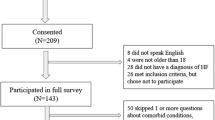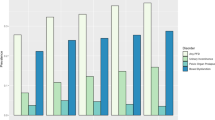Abstract
The dilemma of managing patients with chronic pelvic pain syndromes continues to frustrate physicians confronted with these complaints. Multiple diagnoses traditionally label this condition in men and women and, typically, implicate a pelvic-organ system when, in fact, very little objective evidence for a pathophysiologic process exists. Traditional therapies, consisting of antibiotics, anti-inflammatories, and muscle relaxants, simply do not work, and their lack of efficacy compared with placebo has been documented by randomized clinical trials in the US that were sponsored by the NIH. What do we do now? This review article attempts to describe the clinical efforts of several investigators and to put their patients' outcomes in perspective, and thereby suggest alternative therapies to help these patients.
Key Points
-
Traditional therapy for chronic pelvic pain (CPP) relies on conventional oral agents that have been used for many years without substantial evidence for efficacy
-
Carefully conducted, randomized, placebo-controlled trials show no efficacy for antibiotic therapy in nonbacterial pelvic pain syndromes
-
There is clear evidence that α-blocker therapy could be beneficial in male CPP syndrome
-
There is very little published evidence that CPP implies an inflammatory process, although emerging studies have demonstrated the upregulation of proinflammatory and inflammatory cytokines as well as neurotransmitters
-
Pilot exploration of therapeutic trials designed to inhibit neuromuscular transmission of painful stimuli seem promising, but randomized, controlled studies are necessary
-
CPP, like other chronic pain syndromes, seems to occur as a biopsychosocial phenomenon
This is a preview of subscription content, access via your institution
Access options
Subscribe to this journal
Receive 12 print issues and online access
$209.00 per year
only $17.42 per issue
Buy this article
- Purchase on Springer Link
- Instant access to full article PDF
Prices may be subject to local taxes which are calculated during checkout
Similar content being viewed by others
References
Schaeffer AJ et al. (2002) Overview summary statement, diagnosis, management of chronic prostatitis/chronic pelvic pain syndrome (CP/CPPS). Urology 60: 1–4
Nickel JC et al. (2003) Levofloxacin for chronic prostatitis/chronic pelvic pain syndrome in men: a randomized placebo-controlled multicenter trial. Urology 62: 614–617
Weidner W (2004) Treating chronic prostatitis: antibiotics no, α-blockers maybe. Ann Intern Med 141: 639–640
Alexander RB et al. (2004) Ciprofloxacin or tamsulosin in men with chronic prostatitis/chronic pelvic pain syndrome: a randomized, double-blind trial. Ann Intern Med 141: 581–589
Theodorou C et al. (1999) The urodynamic profile of prostadynia. BJU Int 84: 461–463
Cheah PY et al. (2003) Terazosin therapy for chronic prostatitis/chronic pelvic pain syndrome: a randomized, placebo controlled trial. J Urol 169: 592–596
Mehik A et al. (2003) Alfuzosin treatment for chronic prostatitis/chronic pelvic pain syndrome: a prospective, randomized, double-blind, placebo-controlled, pilot study. Urology 62: 425–429
Nickel JC et al. (2004) Treatment of chronic prostatitis/chronic pelvic pain syndrome with tamsulosin: a randomized, double blind trial. J Urol 171: 1594–1597
Nickel JC et al. (2003) Leukocytes and bacteria in men with chronic prostatitis/chronic pelvic pain syndrome compared to asymptomatic controls. J Urol 170: 818–822
Nickel JC et al. (2003) A randomized, placebo controlled, multicenter study to evaluate the safety and efficacy of rofecoxib in the treatment of chronic nonbacterial prostatitis. J Urol 169: 1401–1405
Bresalier RS et al. (2005) Cardiovascular events associated with rofecoxib in a colorectal chemoprevention trial. N Engl J Med 17: 1092–1102
Rugendorff EW et al. (1993) Results of treatment with pollen extract (Cernilton N) in chronic prostatitis and prostatodynia. Br J Urol 71: 433–438
Hwang P et al. (1997) Efficacy of pentosan polysulfate in the treatment of interstitial cystitis: a meta-analysis. Urology 50: 39–43
Nickel JC et al. (2005) Randomized, double-blind, dose-ranging study of pentosan polysulfate sodium for interstitial cystitis. Urology 65: 654–658
Nickel JC et al. (2005) Pentosan polysulfate sodium therapy for men with chronic pelvic pain syndrome: a multicenter, randomized, placebo controlled study. J Urol 173: 1252–1255
Sairanen J et al. (2005) Cyclosporine A and pentosan polysulfate sodium for the treatment of interstitial cystitis: a randomized comparative study. J Urol 174: 2235–2238
Nickel JC et al. (2004) A randomized placebo-controlled multicentre study to evaluate the safety and efficacy of finasteride for male chronic pelvic pain syndrome (category IIIA chronic nonbacterial prostatitis). BJU Int 93: 991–995
Kaplan SA et al. (2004) A prospective, 1-year trial using saw palmetto versus finasteride in the treatment of category III prostatitis/chronic pelvic pain syndrome. J Urol 171: 284–288
van Ophoven A et al. (2004) A prospective, randomized, placebo controlled, double-blind study of amitriptyline for the treatment of interstitial cystitis. J Urol 172: 533–536
De Rose AF et al. (2004) Role of mepartricin in category III chronic nonbacterial prostatitis/chronic pelvic pain syndrome: a randomized prospective placebo-controlled trial. Urology 63: 13–16
Shoskes DA et al. (1999) Quercetin in men with category III chronic prostatitis: a preliminary prospective, double-blind, placebo-controlled trial. Urology 54: 960–963
Payne CK et al. (2005) Intravesical resiniferatoxin for the treatment of interstitial cystitis: a randomized, double-blind, placebo controlled trial. J Urol 173: 1590–1594
Doggweiler-Wiygul R and Sellhorn E (2002) Role of behavioral changes and biofeedback in urology. World J Urol 20: 302–305
Glazer HI et al. (1995) Treatment of vulvar vestibulitis syndrome with electromyographic biofeedback of pelvic floor musculature. J Reprod Med 40: 282–290
McKay E et al. (2001) Treating vulvar vestibulitis with electromyographic biofeedback of pelvic floor musculature. J Reprod Med 46: 337–342
Glazer HI et al. (1999) Pelvic floor muscle surface electromyography. J Reprod Med 44: 779–782
Clemens JQ et al. (2000) Biofeedback, pelvic floor re-education, and bladder training for male chronic pelvic pain syndrome. Urology 56: 951–955
Cornel EB et al. (2005) The effect of biofeedback physical therapy in men with chronic pelvic pain syndrome type III. Eur Urol 47: 607–611
Kaplan SA et al. (1994) Urodynamic evidence of vesical neck obstruction in men with misdiagnosed chronic nonbacterial prostatitis and the therapeutic role of endoscopic incision of the bladder neck. Urol Neurol Urodyn 152: 2063–2065
Nickel JC and Sorensen R (1996) Transurethral microwave thermotherapy for nonbacterial prostatitis: a randomized double-blind sham controlled study using new prostatitis specific assessment questionnaires. J Urol 155: 1950–1955
Serel TA et al. (1997) Treatment with neodymium:YAG laser in patients with chr onic prostatitis: a preliminary report. Intl Urol Nephrol 29: 53–58
Leskinen MJ et al. (2002) Transurethral needle ablation for the treatment of chronic pelvic pain syndrome (category III prostatitis): a randomized sham-controlled study. Urology 60: 300–304
Chiang PH and Chiang CP (2004) Therapeutic effect of transurethral needle ablation in non-bacterial prostatitis: chronic pelvic pain syndrome type IIIa. Intl J Urol 11: 97–102
Ripoll E and Mahowald D (2002) Hatha yoga therapy management of urologic disorders. World J Urol 20: 306–309
Jacobson E (1929) Progressive Relaxation. Chicago and London: The University of Chicago
Wise D and Anderson RU (2005) A Headache in the Pelvis: A New Understanding and Treatment for Prostatitis and Chronic Pelvic Pain Syndromes, edn 3, 19–170. Occidental, CA: National Center for Pelvic Pain Research
Anderson RU et al. (2005) Integration of myofascial trigger point release and paradoxical relaxation training for treatment of chronic pelvic pain. J Urol 174: 155–160
Savidge CJ and Slade P (1997) Psychological aspects of chronic pelvic pain. J Psychosom Res 42: 433–444
Miller HC (1988) Stress prostatitis. Urology 32: 507–510
Gatenbeck L et al. (1987) Stress stimuli-induced histopathological changes in the prostate: an experimental study in the rat. Prostate 11: 69–75
Chen R and Nickel JC (2003) Acupuncture ameliorates symptoms in men with chronic prostatitis/chronic pelvic pain syndrome. Urology 61: 1156–1159
Honjo H et al. (2004) Effects of acupuncture for chronic pelvic pain syndrome with intrapelvic venous congestion: preliminary results. Int J Urol 11: 607–612
Maan Z et al. (2004) Alternative use of botulinum toxin in urology. Expert Opin Pharmacother 5: 1015–1021
Mense S (2004) Neurobiological basis for the use of botulinum toxin in pain therapy. J Neurol 251 (Suppl 1): 11–17
Zermann D et al. (2000) Perisphincteric injection of botulinum toxin type A: a treatment option for patients with chronic prostatic pain? Eur Urol 38: 393–399
Jarvis SK et al. (2004) Pilot study of botulinum toxin type A in the treatment of chronic pelvic pain associated with spasm of the levator ani muscles. Aust NZ J Obstet Gynaecol 44: 46–50
Smith CP et al. (2004) Botulinum toxin A has antinocioceptive effects in treating interstitial cystitis. Urology 64: 871–875
Cui M et al. (2004) Subcutaneous administration of botulinum toxin type A reduces formalin-induced pain. Pain 107: 125–133
Leippold T et al. (2003) Botulinum toxin as a new therapy option for voiding disorders: current state of art. Eur Urology 44: 165–174
Goschel H et al. (1997) Botulinum A toxin therapy: neutralizing and nonneutralizing antibodies-therapeutic consequences. Exp Neurol 147: 96–102
Comiter CV (2003) Sacral neuromodulation for the symptomatic treatment of refractory interstitial cystitis: a prospective study. J Urol 169: 1369–1373
Chai TC et al. (2000) Percutaneous sacral third nerve root neurostimulation improves symptoms and normalizes urinary HB-EGF levels and antiproliferative activity in patients with interstitial cystitis. Urology 55: 643–646
Fitzwater JB et al. (2003) Electrical stimulation in the treatment of pelvic pain due to levator ani spasm. J Reprod Med 48: 573–577
Nappi RE et al. (2003) Electrical stimulation (ES) in the management of sexual pain disorders. J Sex Marital Ther 29: 103–110
Peters KM and Konstandt D (2004) Sacral neuromodulation decreases narcotic requirements in refractory interstitial cystitis. BJU Int 93: 777–779
Siegel S et al. (2001) Sacral nerve stimulation in patients with chronic intractable pelvic pain. J Urol 166: 1742–1745
John H et al. (2003) A new high frequency electrostimulation device to treat chronic prostatitis. J Urol 170: 1275–1277
Schmidt RA et al. (1999) Sacral nerve stimulation for treatment of refractory urinary urge incontinence. J Urol 162: 352–357
Deer TR (2001) Current and future trends in spinal cord stimulation. Curr Pain Headache Rep 5: 503–509
Rowe E et al. (2005) A prospective, randomized, placebo controlled, double-blind study of pelvic electromagnetic therapy for the treatment of chronic pelvic pain syndrome with 1 year of follow-up. J Urol 173: 2044–2047
Ramsden CE et al. (2003) Pudendal nerve entrapment as source of intractable pain. Am J Phys Med Rehabil 82: 479–484
Robert R et al. (1998) Anatomic basis of chronic perineal pain: role of the pudendal nerve. Surg Radiol Anat 20: 93–98
Amarenco G et al. (1997) Treatments of perineal neuralgia caused by involvement of the pudendal nerve. Rev Neurol (Paris) 153: 331–334
Shafik A (1998) Pudendal canal syndrome as a cause of vulvodynia and its treatment by pudendal nerve decompression. Eur J Obstet Gynecol Reprod Biol 80: 215–220
Bautrant E et al. (2003) Modern algorithm for treating pudendal neuralgia: 212 cases and 104 decompressions. J Gynecol Obstet Biol Reprod (Paris) 32: 705–712
Magni G et al. (1986) Psychological findings in chronic anal pain. Psychopharmacology 1: 170–174
Henry C et al. (1991) Chronic anogenital and perineal pain. Clinical and psychopathological characteristics of a syndrome. Rev Med Suisse Romande [French] 111: 27–32
Mauillon J et al. (1999) Results of pudendal nerve neurolysis-transposition in twelve patients suffering from pudendal neuralgia. Dis Colon Rectum 42: 186–192
Author information
Authors and Affiliations
Corresponding author
Ethics declarations
Competing interests
The author declares no competing financial interests.
Rights and permissions
About this article
Cite this article
Anderson, R. Traditional therapy for chronic pelvic pain does not work: what do we do now?. Nat Rev Urol 3, 145–156 (2006). https://doi.org/10.1038/ncpuro0438
Received:
Accepted:
Issue Date:
DOI: https://doi.org/10.1038/ncpuro0438
This article is cited by
-
The role of pelvic floor therapies in chronic pelvic pain syndromes
Current Prostate Reports (2008)
-
Frequency, urgency, and pelvic pain: Treating the pelvic floor versus the epithelium
Current Urology Reports (2006)



